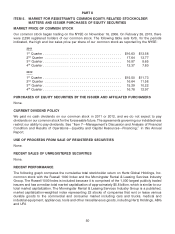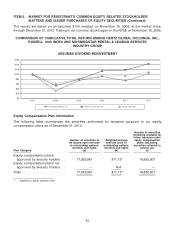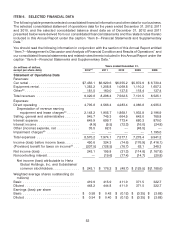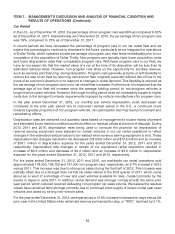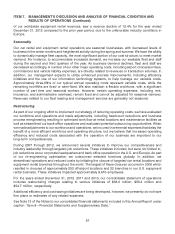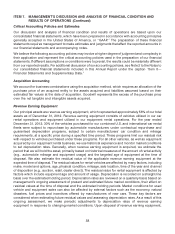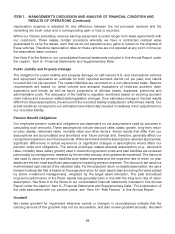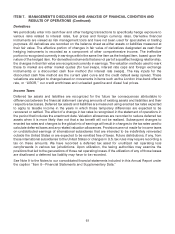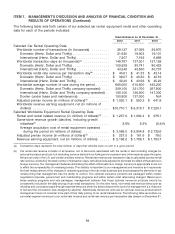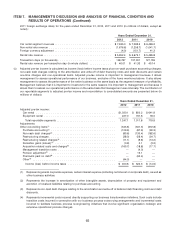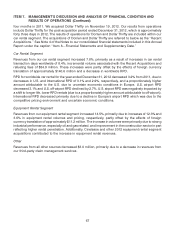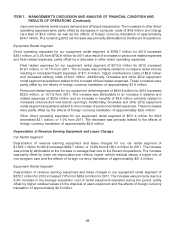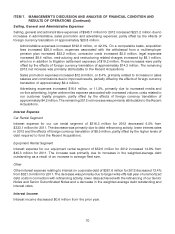Hertz 2012 Annual Report Download - page 84
Download and view the complete annual report
Please find page 84 of the 2012 Hertz annual report below. You can navigate through the pages in the report by either clicking on the pages listed below, or by using the keyword search tool below to find specific information within the annual report.ITEM 7. MANAGEMENT’S DISCUSSION AND ANALYSIS OF FINANCIAL CONDITION AND
RESULTS OF OPERATIONS (Continued)
impairment is deemed to exist if the carrying value of goodwill exceeds its fair value. Goodwill must be
tested at least annually using a two-step process. The first step is to identify any potential impairment by
comparing the carrying value of the reporting unit to its fair value. A reporting unit is an operating
segment or a business one level below that operating segment (the component level) if discrete financial
information is prepared and regularly reviewed by segment management. However, components are
aggregated as a single reporting unit if they have similar economic characteristics. We estimate the fair
value of our reporting units using a discounted cash flow methodology. The key assumptions used in the
discounted cash flow valuation model for impairment testing include discount rates, growth rates, cash
flow projections and terminal value rates. Discount rates are set by using the Weighted Average Cost of
Capital, or ‘‘WACC,’’ methodology. The WACC methodology considers market and industry data as well
as Company specific risk factors for each reporting unit in determining the appropriate discount rates to
be used. The discount rate utilized for each reporting unit is indicative of the return an investor would
expect to receive for investing in such a business. The cash flows represent management’s most recent
planning assumptions. These assumptions are based on a combination of industry outlooks, views on
general economic conditions, our expected pricing plans and expected future savings generated by our
past restructuring activities. Terminal value rate determination follows common methodology of
capturing the present value of perpetual cash flow estimates beyond the last projected period assuming
a constant WACC and low long-term growth rates. If a potential impairment is identified, the second step
is to compare the implied fair value of goodwill with its carrying amount to measure the impairment loss.
A significant decline in the projected cash flows or a change in the WACC used to determine fair value
could result in a future goodwill impairment charge.
In the fourth quarter 2012, we performed our annual impairment analysis based upon market data as of
October 1, 2012 and concluded that there was no impairment related to our goodwill and our other
indefinite lived intangible assets. At October 1, 2012, we had five reporting units: U.S. Car Rental, Europe
Car Rental, Other International Car Rental, Donlen and Worldwide Equipment Rental.
We performed the impairment analyses for our reporting units, using our business and long-term
strategic plans, revised to reflect the current economic conditions. Our weighted average cost of capital
used in the discounted cash flow model was calculated based upon the fair value of our debt and our
stock price with a debt to equity ratio comparable to our industry. The total fair value of our reporting
units was then compared to our market capitalization to ensure their reasonableness.
See Note 3 to the Notes to our consolidated financial statements included in this Annual Report under
the caption ‘‘Item 8—Financial Statements and Supplementary Data.’’
Intangible and Long-lived Assets
We re-evaluate the estimated useful lives of our intangible assets annually or as circumstances change.
Those intangible assets considered to have indefinite useful lives, including our trade name, are
evaluated for impairment on an annual basis, by comparing the fair value of the intangible assets to their
carrying value. Intangible assets with finite useful lives are amortized over their respective estimated
useful lives. In addition, whenever events or changes in circumstances indicate that the carrying value of
intangible assets might not be recoverable, we will perform an impairment review.
The valuation of our indefinite lived assets utilized the relief from royalty method, which incorporates
cash flows and discount rates comparable to those discussed above. We also considered the excess
earnings as a percentage of revenues to ensure their reasonableness. Our analysis supported our
conclusion that an impairment did not exist.
60


